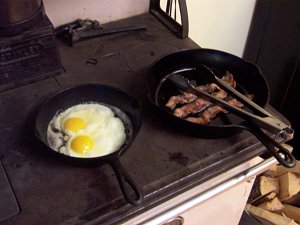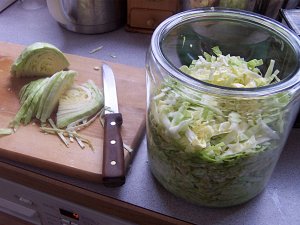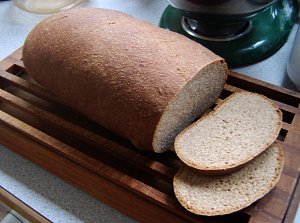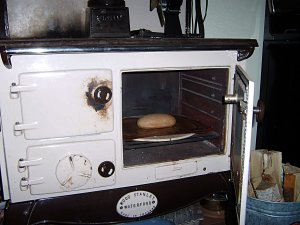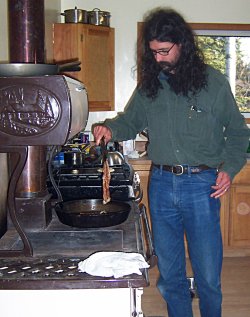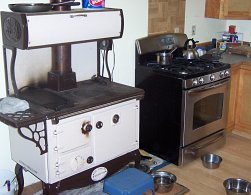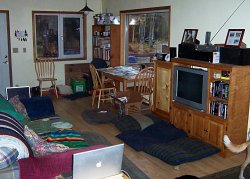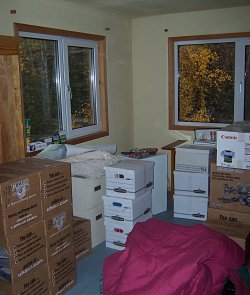Not getting tired of cooking food on the wood stove yet, and I’m not tired of showing you how cool it is either…
In addition to baking some bread from Reinhart’s whole grain bread book (see my review here), I finally got around to dealing with the cabbage we grew in our garden at the old house. We planted ten plants and all of them produced, but the cabbages weren’t all that large (“bigger than a softball, smaller than a bowling ball”). Today I chopped them up, salted and pressed them into what will become sauerkraut in a couple months. Last year’s sauerkraut was a little mild, so I’ll let it go longer this year. The glass container holds a gallon, and it’s about 80% full with this year’s production. Not bad, and probably as much sauerkraut as I’ll be able to eat this year. If it comes out OK, I may need to investigate corning the brisket from our side of Delta beef.
Thinking of Reuben sandwiches on homemade whole grain rye bread. Mmm…
A couple weeks ago I finished reading Peter Reinhart’s Whole Grain Breads, and baked my first loaf. I chose the whole wheat sandwich loaf even though I much prefer hearth breads because it was the teaching recipe that all the other recipes are based on. The bread was fantastic; sweet, not too dry, and with a lot of wheat flavor. And, best of all for a homemade sandwich bread, it lasted until Friday without losing any of it’s flavor or character.
I have also made the whole wheat pizza dough twice, and it’s equally good. Our previous dough recipe was Cook Illustrated’s 75-minute pizza dough, which tastes pretty good, and has sufficient gluten development to form a pizza crust, but once it’s baked with sauce, toppings and cheese, it’s not really strong enough to handle picking up the slices. The whole wheat dough was sturdy enough, and again, it had the same sweet wheat flavor and nice texture as the sandwich loaf. The recipe in the book makes five individual pizzas, which was more dough that I needed for a single large pizza (I reduced the recipe by 25% the second time around and it was perfect) so I used the leftover dough the next day to bake a small loaf in the wood stove oven. The oven was around 425°F, which is a little hotter than the baking temperatures in the book, and I should have rotated the loaf half-way through because the oven heat isn’t very even, but the loaf came out great.
Since then I’ve made whole wheat hearth bread, which was tasty, but lost some of it’s height when I transferred it to the baking stone (I’ve got a Super Peel coming, which should help with this problem), and oat bran broom bread. Both came out great tasting with excellent crumb, and still had great texture and flavors when I finished the loaf.
The method used in almost all the breads in the book is different than any of the techniques I’ve seen in other books. Most quality breads have a long pre-ferment, either using sourdough or a lightly yeasted dough that rises slowly overnight and is mixed in on baking day, and usually feature low amounts of yeast which require long several-stage fermentation on baking day to develop gluten and the yeast. Reinhart’s method for developing the dough is to use a lightly yeasted pre-ferment as in the other recipes, plus an soaker that rests overnight at room temperature. These two doughs form the majority of the final dough. They’re mixed on baking day with the rest of the ingredients, and a relatively large amount of yeast. Since the flavors and structure has already been developed in the two overnight doughs, there’s no reason for a long fermentation on baking day. The technique also works wonders on whole grain flours, which can result in dense loaves in traditional recipes.
The result is bread with all the flavor and keeping potential of traditional recipes but you can use much higher percentages (like 100%) of whole grain flours with greater confidence that the bread will turn out, and best of all, baking day becomes a two hour process, rather than a four to six hour, multiple stage, slow fermentation procedure. I’m not going to abandon my other bread books, but it’s great to have more techniques at my disposal when deciding what kind of bread to make. And Reinhart can be commended for all the research and testing he did to develop the methods in this book.
I highly recommend Whole Grain Breads to anyone who is really interested in bread baking, especially if you’re ready to jump onto the whole grain bandwagon.
It was another cold day this morning, and since we moved all the split firewood from our old house yesterday, we decided to make a fire in our wood burning cookstove. We got the replacement firebox parts earlier in the week, and they slid right into place. We’ve got about a cord stacked in the woodshed, and another cord of spruce that’s been cut, but not split yet. Hopefully the split wood will last long enough to allow the spruce to dry once I’ve chopped it. With everything else going on, I haven’t had any opportunity to go logging, or even deal with the wood I got earlier in the spring.
The Stanley fired right up, and within about fifteen minutes the top cook surfaces ranged from 700°F above the firebox, to 200°F on the cooking plates on the right side of the stove. The oven peaked at 180°F after 45 minutes, but by then the house was already warm and I’d burned all the wood I brought into the house, so I didn’t let it go any longer. I’m not exactly sure how to use the flue controls on the stove to regulate the cooktop and oven temperatures, but it was easy to get the fire started, and then cinched down to burn slowly.
Since today was pancakes and bacon day, and the cookstove was already warm, I tried cooking the bacon on the wood stove. Like the electric stove six months ago, and our new gas stove last week, the wood burning stove heated the pan evenly and the bacon came out perfectly. The cooktop could have been hotter and the bacon would have browned a bit more than it did, but for my first attempt at renewable energy cooking, I’ll mark this one down as a complete success.
Now back to moving. Sigh.
Yesterday I had a chance to actually cook something on our new stove. We got it on Wednesday, moved it into the house on Thursday, converted it to propane and hooked it up on Friday, but we’ve been so busy with moving and taking care of Ivan that we hadn’t had a chance to do anything except boil water on it. I made pancakes and bacon. The stove has a large oval shaped central burner with a griddle that fits over the top of it, but I used our cast-iron griddle on the left two burners instead. Like the electric range we bought six months ago, the new stove is able to heat my biggest cast-iron pan from edge to edge and cooked a full pan of bacon evenly with a minimum of rotating.
The pancakes weren’t as good because I need to learn the correct burner settings again. I'd just gotten used to the electric, but I'm already enjoying the gas stove. It's nice even heat, it's really easy to manipulate the burner settings because you can actually see the flame. This particular stove has a simmer burner in addition to the central griddle. I tried the simmer burner last night, but I think it’s set a bit to high at the moment.
We debated getting a dual-fuel range but Consumer Reports tested electric and gas ranges in July and didn't find any differences in evenness or temperature control between the two, and the dual-fuel models we saw were all more than twice as expensive as a single fuel range. I bake a lot of bread, so I think the moisture produced during propane combustion might actually be a good thing for the crust. I'm hoping to have a bit of time during the week to try out a recipe from my new bread book.
Soon we should also receive the firebox parts for our wood-burning cook stove. Last weekend I managed to get all the melted, warped, and cracked pieces (!) of cast-iron out of the firebox, and called Lehman's. They sell the stove we have, and also sell parts for it. Shipping all that cast iron from Ohio to Alaska is going to cost more than $100. But it'll be worth it. It's been cold and rainy all weekend and I wished I could have fired up the wood stove. Gotta move some firewood from the old house.
On the subject of temperatures, we’ve already noticed that it’s much colder at our place than in the rest of town, and certainly by comparison to our old house in the hills. I’ve got a little plot on the sidebar (labelled ‘Temperature anomaly’) that shows the difference between the morning temperature at our house, and an average of the temperature readings from the Fairbanks area. Each blue bar represents a single day’s observation going back two weeks and the orange lines show the average anomaly for each week. Thus far, it appears that we’re about 10 degrees below the Fairbanks average when it’s clear, and pretty close to average when it’s cloudy.
We're still moving stuff from the old house to the new one, but are nearing the end of that process. Unpacking has now overtaken packing so the house is starting to look more like a place that people live, rather than an empty storage unit. We’ve got the first floor set up much the way the previous owners had it set up with a little entry way / pantry next to the door, a “dining room” in front of the big south window, the entertainment center next to the sliding glass doors, and a couch on the opposite wall (formerly known as the “red wall”.) Right now we’re using a bookshelf as shelves for the pantry, and we haven’t figured out what to do with the area to the right of the couch (where there was a little office), but at least it’s functional. I think some sort of storage bench next to the door, a storage unit under the window, and a better pantry unit will help organize things quite a bit before the complexities (coats, boots, snow, extreme cold, etc.) of winter arrive.
Most of the stuff that had been in the library / junk room in our old house, as well as the stuff from the office (we had a lot of rooms in the old house…) have been shoved into the third room on the second floor of our new house. This is supposed to become an office in the near future, but at the moment it’s looking a lot more like a new take on the “junk room” concept. The red cabin, which is absorbing everything from the garage also has this appearance. Until we can get a handle on unpacking some of the boxes, both areas are going to be pretty hard to navigate.
Still, it’s all progress. I’m sure it’ll be awhile before it really feels like home, but having a bunch of our normal stuff close by and out in similar places certainly helps.
